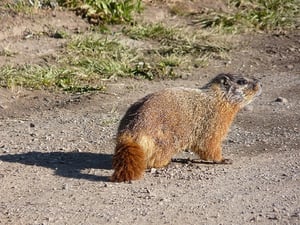 The vernal equinox, or the first day of spring took place on March 20th at 5:21 P.M. Meaning, the Sun’s path across the sky crossed the equator providing the planet with an equal amount of daylight and darkness. We can expect more sunlight everyday until we reach the summer solstice on June 21st. Average temperatures are already greater than they were a month ago, and will continue to rise well past the longest day of the year in June.
The vernal equinox, or the first day of spring took place on March 20th at 5:21 P.M. Meaning, the Sun’s path across the sky crossed the equator providing the planet with an equal amount of daylight and darkness. We can expect more sunlight everyday until we reach the summer solstice on June 21st. Average temperatures are already greater than they were a month ago, and will continue to rise well past the longest day of the year in June.
Although the snow hasn't stopped yet in Vail, winter is officially over, but not necessarily for the Yellow-bellied Marmot (Marmota flaviventris). If you’ve been outdoors in the Vail valley during summer, then chances are you have heard or seen this animal. Unless you were picking up boulders this winter, you haven’t seen a Marmot since October when they retreated to their burrows under rocks for a six to eight month commitment to sleep.
Marmots are textbook hibernators, with the oldest and fattest entering their burrows starting in October. Imagine gaining 30% of your body weight from summer to autumn, that’s what this little fur-ball does! The Marmot’s weight increases in the form of brown fat stored over most of its body. Brown fat acts like a heat pad for the hibernating animal; it warms the body without any need to shiver.
During hibernation, its heart rate drops from 100 to four beats per minute, respiration rate slows to one breath every few minutes and body temperature falls 50 degrees. This allows the Marmot to use very little energy and live off of its fat reserves for the duration of winter. Its metabolism slows so drastically, a marmot falls into a very deep sleep and little will wake it from its slumber. Marmots will wake occasionally during winter (about every two weeks) to defecate. This may occur in special chambers below ground or, less frequently, on the surface. Once the deed is done, they return to their grass bed for more rest.
If the Marmot eats enough plant matter in the fall and weather conditions are just right, it will be lucky enough to hibernate through mid-April. If this animal comes out of hibernation too early, it will be vulnerable to predators, have a hard time finding food, and waste valuable brown fat reserves needed to sustain it through some more cold days ahead.
Males usually exit a few days earlier than females in late March, April or sometimes in May. They will emerge having lost approximately one half their fall body weight. Mating generally occurs within the first two weeks following emergence from hibernation. Young Marmots emerge from the natal den in late June and July with weaning occurring in mid-July. Keep your eyes pealed very soon for our waking old friend, especially near talus fields on south facing slopes.
Author Brock Nedland is an Educator for Walking Mountains Science Center. When he’s not out exploring nature with the kids, he enjoys snowboarding or fly fishing in our beautiful surroundings. Would you like to learn more about local critters? Visit us at the Nature Discovery Center daily at 3pm for free nature tours.









